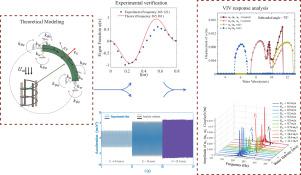International Journal of Mechanical Sciences ( IF 7.3 ) Pub Date : 2021-11-10 , DOI: 10.1016/j.ijmecsci.2021.106903 Kunjie Sun 1 , Xiaochun Nie 2 , Ting Tan 3 , Zhengyue Yu 1 , Zhimiao Yan 1

|
The existing studies on mathematical modeling for the forced vibration response of naturally curved beams under elastic boundary conditions mainly focus on slightly curved structures. This work proposes the mathematical model for naturally curved beam with a large curvature under the elastic boundary. Under the assumption of small deformations, the six degrees of freedom are reduced to four degrees of freedom through spatial bending beam theory and differential geometry. The dynamics governing equations of the naturally curved beam are derived using Hamilton’s principle and Frenet–Serret formula. An improved Van der Pol model is introduced to investigate the vortex induced vibration (VIV) or vortex induced divergence (VID) response. Hammer test, wind tunnel experiment and finite element method validate the proposed model for spatially curved helical beam. It is found that under the fixed boundary condition, transposition occurs in the first two coupled modes in the normal direction of the helical beam. The errors of the first two nature frequencies are 0.016% and 0.088%, respectively. The modal analysis under the elastic boundary shows that the first-order decoupled modes in each direction will “disappear” with the variation of stiffness. Under the boundary condition of small stiffness, the first two modes of the normal direction change abruptly at the subtended angle of . This abrupt change produces negative damping and leads to structural unstability. When the first two frequencies are close to each other, the water velocity region of VIV or VID response will intersect and the orthogonal modes in normal direction should be calculated coupled. In this case, the amplitude of the first order mode in the normal direction will always be greater than that of the second order mode. The maximum amplitude in direction can reach 0.014 m. The obtained results provide useful information for further research on the fluid-induced vibration response of natural large-curved beam .
中文翻译:

具有弹性支撑的空间大弯曲梁的耦合涡激建模
现有关于弹性边界条件下自然弯曲梁受迫振动响应数学建模的研究主要集中在微弯曲结构上。本文提出了弹性边界下大曲率自然弯曲梁的数学模型。在小变形假设下,通过空间弯曲梁理论和微分几何,将六个自由度降为四个自由度。自然弯曲梁的动力学控制方程是使用汉密尔顿原理和 Frenet-Serret 公式推导出来的。引入改进的 Van der Pol 模型研究涡激振动(VIV) 或涡旋诱导发散 (VID) 响应。锤击试验、风洞试验和有限元方法验证了所提出的空间弯曲螺旋梁模型。发现在固定边界条件下,在螺旋梁法线方向的前两种耦合模式中发生转置。前两个自然频率的误差分别为 0.016% 和 0.088%。所述下弹性边界示出了第一阶解耦在每个方向将“消失”与刚度的变化模式的模态分析。在小刚度边界条件下,法线方向的前两个模态在对角为. 这种突然的变化会产生负阻尼并导致结构不稳定。当前两个频率相互接近时,VIV 或 VID 响应的水速区域将相交,法向正交模式应耦合计算。在这种情况下,法线方向上一阶模态的幅度将始终大于二阶模态的幅度。最大振幅在方向可达0.014 m。所得结果为进一步研究自然大弯曲梁的流体激振响应提供了有用的信息。


























 京公网安备 11010802027423号
京公网安备 11010802027423号